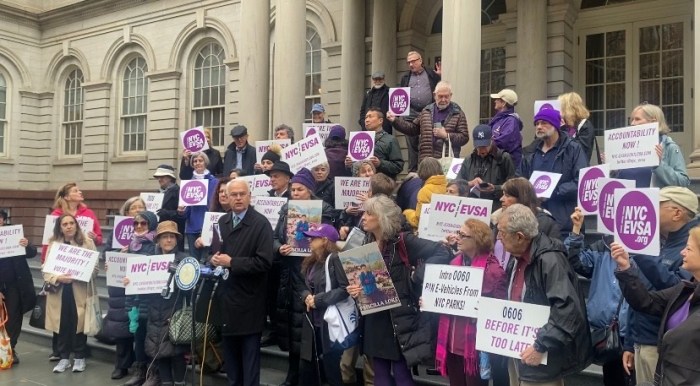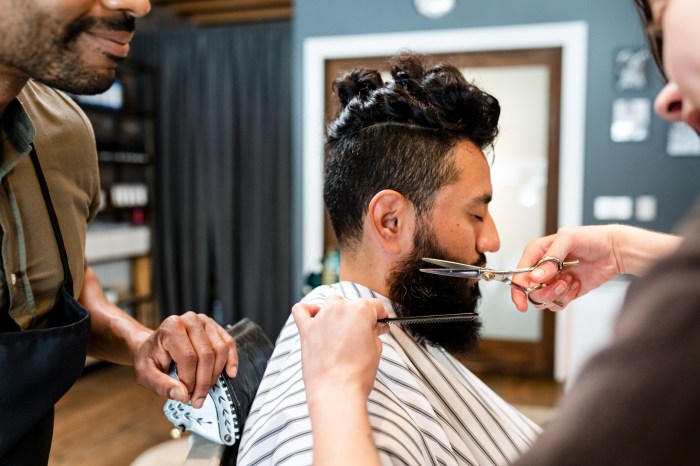By Arlene McKanic
If anyone needs an excuse to go out to the beautiful Rockaway peninsula, there’s now Artsplash 2002 at the Rockaway Artists’ Alliance at Fort Tilden, a huge exhibit featuring 50 artists and spread over its complex of sTudios 6 and 7 and its Moonstage. Unlike the admirable Queens International show now at the Queens Museum of Art, the energy of this exhibit is distinctly laid back and has a nearly childlike sweetness — was it because it’s so close to the ocean?
The exhibit begins in sTudio 6 with Maryann McEvoy’s beautiful quilts, one called “Dancing Flowers,” and another round, scarlet kaleidoscopic work. Nearby are McEvoy’s “Doll Collages,” little paintings and objects in shadow boxes that have been distressed to seem older than they are, like tiny portraits of dolls found in pre-Revolutionary house attics.
Patricia Grace’s “Untitled House” is in this same vein, as is her “Amish Dolls Do Not Have Faces.” Nearby are Elke Fontillo’s “Shells,” wall hangings fashioned after large seashells, including one that’s a bubbling fountain.
The Alliance also teamed up with the Brooklyn Watercolor Society for a “Paintout” — where a bunch of artists went all over Fort Tilden and painted what they saw. Loretta Poole’s “Rockaway Treasure” is a painting of a broken shell. This is how you usually find whelks on the beach, but Poole brings out its pearlescent beauty. Robert Axelrod’s “Abandoned” shows an empty but still healthy looking stucco house and Theresa Ferrier’s “Mansion in the Pines, Fort Tilden” is different as it is not a beach scene but shows a red house in the middle of woods not usually associated with this military base on the windy Atlantic coastline.
Judith Kundhardt was represented with “Opened Shell.” Two halves of a shell rest on the sand, one half turned up to reveal its nacreous interior. M. Elliott Killian’s “Interior/Exterior” shows a view of dunes through the fenestrations of an abandoned house, while her “Fresh Water Pond” depicts reflections of reeds in a still pond that holds what looks like exactly three goldfish and a log. Ruth Hall’s “Tall Tree” is another rare woodland scene and her “Breezy Point” is a scene of people on the beach. The matte board is cheerfully speckled with blues and pinks and purples.
The outdoor sculptures include Ursula Clark’s “Twins” and “Daphne’s Lar” [sic], Nicolae Golici’s “Mogra,” and Denis Macrae’s “Wood Sculpture.” “Daphne’s Lar” is a throne of red branches set up in the center of the lacy iron grill of the Moonstage. Behind it is the disheveled garden, behind which stands the empty warehouse the Alliance intends to do use some point in the future.
When you leave the Moonstage, you enter sTudio 7, the great unheated barn where most of the work is installed. B. Fischer had four photographs, “Leaves,” “Dock of the Bay,” “Crow’s Nest” and “Rockets.”
Louanne Arnheiter’s “Rockaway Olympia” is a nude self portrait — the artist reclines on a purple récamier sofa against a background of purple wisteria. Her “Dolphin Serenade” is a lovely oil on canvas work of a girl playing a flute on a beach. William Finnin’s “Daisy the Scare Vulture” is a mixed media sculpture of a buzzard on a nest, but not any old’ buzzard. Daisy has a happy head plume of hot pink feathers. Her nest holds three eggs and one of them is hatching, thus mitigating the creature’s creepiness.
Margaret Massa’s “Like A Medieval Knight” and “The Whole of Time” are tableaux in shadow boxes, bordered by Jean Jackson Moore’s “Ibbibo Deformation Mask,” a varnished, somewhat rearranged horseshoe crab shell and her wonderful “Fulani Woman,” a golden African mask adorned with colorful beads.
Robert Sarnoff’s “The ol’ jetty,” “Peaceful x2” and “Then and Now x3,” are seascapes, with the latter containing three views of a bridge just before nightfall.
“Pink Lupine: New Zealand,” “Hibiscus” and “Monarch” are scrumptious color photos by Holly Gordon, one of a monarch butterfly on what looks like a red violet buddleia, the second of an erotic red hibiscus, and the last a shot of lupines before a blue lake and mountains.
“Pushing Forward” is a jewel-like, semi-pointillist shape-shifting aquatic piece by Callie Danae Hirsch; it was so beautiful I wanted to put it on and wear it.
“Ri,” by Ana Golici, is a five-framed photo of what looks like an orchid and my personal favorite was “Pedicure,” by Jennifer Fischer, a whimsical black and white photo of two pairs of canoodling feet with painted toenails.
“Maine Images” are black and white photos by Joseph Rothenberg that show the details of houses, buoys, oars in a rowboat, and a church steeple. “He,” “She and Horses,” “Kristina,” “Cleopatra,” “Kurilka,” “Freeze Bird” and “Dali” are a series of Picassoesque oils by Victor Zinuhov, though Dali, more light in mood, reminded me more of Paul Klee.
“Untitled Touching,” “Untitled Vortex” and “Untitled Multiplication” are eerie digital photo manipulations by the usually unsettling Lucille Lacey, while John Russo’s “Serenity” and “Street In Paris” are happy, primitive paintings, one of houses bunched together in a countryside and the other of a Parisian street with flowers and trees tucked into every corner.
Kathleen Hervey’s “Sally Lightfoot” is a photo of a beautiful crab on a rock. The blue, red and yellow beastie looks like he’s happily posing for the photographer.
Ursula Clark’s “Liberty” is a pyramid of beads, pipe cleaners and little stuffed bluebirds and cardinals that you’d buy in a Christmas ornament store. The whole thing hangs from the rafters, and as some of the pipe cleaners are made out of tinsel, the contraption sparkles here and there under the lights.
At first I thought Joan Doblin Vogel’s acrylic triptych was Howard Beach’s Cross Bay Boulevard, with its cheerful restaurants, cafes, dry cleaners and beauty parlors, but it’s actually Beach 116th Street. The artist's “Kennywood” is a lovely, dreamlike pleasure pavilion where an impossible roller coaster shoots out of the picture into the sky.
Viviana Espinosa’s photo, “Blanket on Beach,” looks like the remnants of a beach picnic. Elegant drinking glasses, a plaid blanket, a discarded bouquet of daisies, empty booze bottles, an exotic scarf, a Guatemalan looking purse and other objects seem about to be buried in sand. A tiny fly had landed on the upper left hand corner of the painting when I saw it; it looked like it belonged there, too.
There was also a three-minute-45-second video installation called “Bad Men” by Tony Mara, which featured children riding tricycles, playing with toy guns, tying each other up. The words “West Bank Limited,” showed up from time to time.
Roger Carreau’s color photos, “Looking Through the Port Hole,” “Break in Clouds,” “Storm Approaching,” “End of Summer,” “Sunset from Atop,” and “Looking through the Port Hole of a Wave,” are dramatic depictions of all those things.
Geoff Rawling was working on an merry mural on one of the walls in the largest room called “Just Say YES,” which seemed to be the theme of the whole show. A great surfable wave emerged from the wall, made of hardened foam and then painted.
Artsplash 2002 will be at RAA through Nov. 3, and gallery hours are Saturdays noon – 5 p.m. and Sundays 1 – 4 p.m. The exhibit is presented in partnership with Gateway National Recreation Area.


































